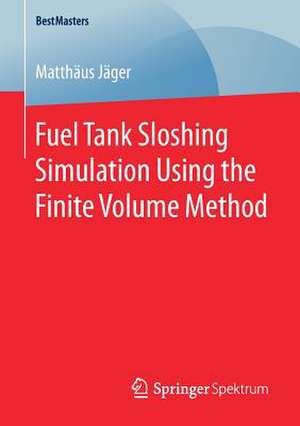Fuel Tank Sloshing Simulation Using the Finite Volume Method: BestMasters
Autor Matthäus Jägeren Limba Engleză Paperback – 7 feb 2019
Din seria BestMasters
-
 Preț: 362.32 lei
Preț: 362.32 lei - 13%
 Preț: 367.41 lei
Preț: 367.41 lei -
 Preț: 364.14 lei
Preț: 364.14 lei - 5%
 Preț: 403.96 lei
Preț: 403.96 lei -
 Preț: 377.18 lei
Preț: 377.18 lei -
 Preț: 367.05 lei
Preț: 367.05 lei - 13%
 Preț: 364.57 lei
Preț: 364.57 lei - 13%
 Preț: 366.14 lei
Preț: 366.14 lei - 13%
 Preț: 368.35 lei
Preț: 368.35 lei -
 Preț: 391.41 lei
Preț: 391.41 lei - 13%
 Preț: 367.41 lei
Preț: 367.41 lei -
 Preț: 311.76 lei
Preț: 311.76 lei -
 Preț: 396.86 lei
Preț: 396.86 lei -
 Preț: 406.59 lei
Preț: 406.59 lei -
 Preț: 365.66 lei
Preț: 365.66 lei -
 Preț: 394.31 lei
Preț: 394.31 lei - 13%
 Preț: 365.83 lei
Preț: 365.83 lei - 13%
 Preț: 396.42 lei
Preț: 396.42 lei - 20%
 Preț: 366.22 lei
Preț: 366.22 lei -
 Preț: 364.14 lei
Preț: 364.14 lei -
 Preț: 367.05 lei
Preț: 367.05 lei -
 Preț: 346.23 lei
Preț: 346.23 lei -
 Preț: 365.59 lei
Preț: 365.59 lei -
 Preț: 392.13 lei
Preț: 392.13 lei -
 Preț: 251.34 lei
Preț: 251.34 lei - 20%
 Preț: 292.10 lei
Preț: 292.10 lei -
 Preț: 404.05 lei
Preț: 404.05 lei -
 Preț: 393.58 lei
Preț: 393.58 lei -
 Preț: 393.58 lei
Preț: 393.58 lei -
 Preț: 344.87 lei
Preț: 344.87 lei -
 Preț: 410.77 lei
Preț: 410.77 lei -
 Preț: 411.75 lei
Preț: 411.75 lei -
 Preț: 379.30 lei
Preț: 379.30 lei -
 Preț: 411.32 lei
Preț: 411.32 lei -
 Preț: 412.89 lei
Preț: 412.89 lei -
 Preț: 377.73 lei
Preț: 377.73 lei -
 Preț: 378.12 lei
Preț: 378.12 lei -
 Preț: 412.51 lei
Preț: 412.51 lei -
 Preț: 481.79 lei
Preț: 481.79 lei -
 Preț: 377.18 lei
Preț: 377.18 lei -
 Preț: 480.06 lei
Preț: 480.06 lei -
 Preț: 376.04 lei
Preț: 376.04 lei -
 Preț: 382.95 lei
Preț: 382.95 lei -
 Preț: 377.95 lei
Preț: 377.95 lei -
 Preț: 412.68 lei
Preț: 412.68 lei -
 Preț: 376.80 lei
Preț: 376.80 lei -
 Preț: 380.45 lei
Preț: 380.45 lei -
 Preț: 410.17 lei
Preț: 410.17 lei -
 Preț: 410.94 lei
Preț: 410.94 lei -
 Preț: 380.63 lei
Preț: 380.63 lei
Preț: 377.18 lei
Nou
Puncte Express: 566
Preț estimativ în valută:
72.18€ • 78.38$ • 60.63£
72.18€ • 78.38$ • 60.63£
Carte tipărită la comandă
Livrare economică 23 aprilie-07 mai
Preluare comenzi: 021 569.72.76
Specificații
ISBN-13: 9783658252274
ISBN-10: 3658252278
Pagini: 107
Ilustrații: XI, 109 p. 1 illus.
Dimensiuni: 148 x 210 mm
Greutate: 0.16 kg
Ediția:1st ed. 2019
Editura: Springer Fachmedien Wiesbaden
Colecția Springer Spektrum
Seria BestMasters
Locul publicării:Wiesbaden, Germany
ISBN-10: 3658252278
Pagini: 107
Ilustrații: XI, 109 p. 1 illus.
Dimensiuni: 148 x 210 mm
Greutate: 0.16 kg
Ediția:1st ed. 2019
Editura: Springer Fachmedien Wiesbaden
Colecția Springer Spektrum
Seria BestMasters
Locul publicării:Wiesbaden, Germany
Cuprins
Developing a Fuel Tank with the Help of Computer Aided Engineering (CAE).- Deriving a System of Equations for the Description of Sloshing Phenomena.- Showing the Usability of the Finite Volume Method.- Verifying the Results for Suitable Test Cases.
Notă biografică
After successful completion of his master’s studies at the Technical University of Graz, Austria, Matthäus Jäger is now working as an engineer in the field of computational fluid dynamics for an Austrian fuel tank system manufacturer.
Textul de pe ultima copertă
Matthäus Jäger examines the simulation of liquid-gas flow in fuel tank systems and its application to sloshing problems. The author focuses at first on the physical model and the assumptions necessary to derive the respective partial differential equations. The second step involves the cell-centered finite volume method and its application to fluid dynamic problems with free surfaces using a volume of fluid approach. Finally, the application of the method for different use cases is presented followed by an introduction to the methodology for the interpretation of the results achieved.
Contents
- Developing a Fuel Tank with the Help of Computer Aided Engineering (CAE)
- Deriving a System of Equations for the Description of Sloshing Phenomena
- Showing the Usability of the Finite Volume Method
- Verifying the Results for Suitable Test Cases
Target Groups
- Lecturers and students from the fields of mechanical engineering, mathematics and physics
- Practitioners in the field of computational fluid dynamics
The Author
After successful completion of his master’s studies at the Technical University of Graz, Austria, Matthäus Jäger is now working as an engineer in the field of computational fluid dynamics for an Austrian fuel tank system manufacturer.
Caracteristici
A Study in Mathematics and Physics
